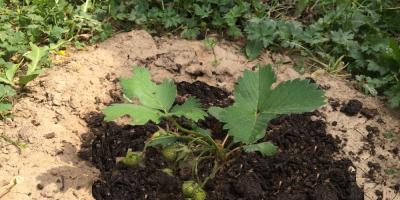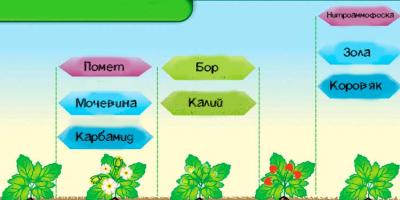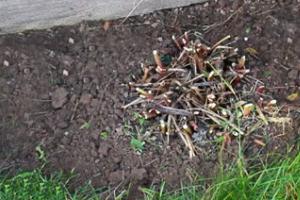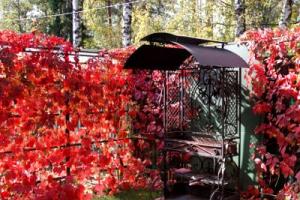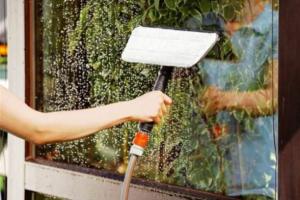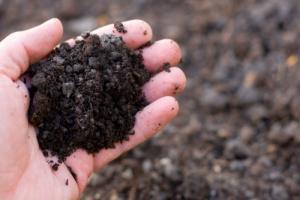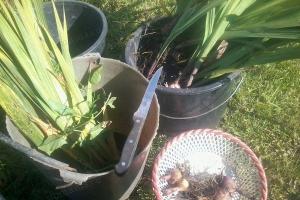If you decide to start growing strawberries, at first you may have a lot of questions. Most often, gardeners without experience do not know what fertilizers are suitable for this berry. Strawberries need to be fed in stages during the fruiting period. Large varieties have a special need for feeding. If you ignore this rule, the berries will turn out small and will lose their taste and juiciness. To improve fruiting, it is necessary to add various compositions. Let's look at them in more detail.
Fertilizers for strawberries during the formation of berries
In late spring and early summer, the plant needs replenishment with potassium fertilizers. In addition, you can apply other fertilizers to garden strawberries:
- At the initial stage of ovary formation, it is recommended to feed the plant with wood ash. The product is scattered between the rows (1 handful is required for 1 bush). Based on it, you can prepare a solution (1 glass of ash per 1 liter of boiling water). The liquid is diluted with water to obtain 10 liters of the composition. For 1 bush you need to add 1 liter of mixture.
- Potassium monophosphate gives good results. To obtain a nutritional composition based on it, 1 tbsp. l. substances must be diluted in 1 bucket of water. This amount will be enough to feed 5 bushes. Before applying a product to improve yield, it is recommended to water the plantings.
- From ready-made products, Kemira Lux or Universal is suitable. These products are diluted with ammonium nitrate or potassium sulfate in a 1:1 ratio. For 1 bush it will take 1 tsp. the resulting liquid.
Do you feed strawberries during fruiting?
Not every novice gardener is aware that strawberries need fertilizing during the fruiting period. It is extremely important to apply the following fertilizers to the bush:
- A solution based on mullein is a universal fertilizer. You can dilute the humus with water in a ratio of 1:15, close the container and let the product brew for 2-3 days. For 1 plant you will need 1 liter of composition. Strawberries respond well to chicken manure. This product is diluted with water in a ratio of 1:30. Infuse the liquid for at least 2-3 days. It is important that the container is well closed. Add 1 liter of infusion to each bush.
- Nettle-based infusion is no less effective. Fill the bucket with raw materials and warm water. Duration of infusion is 2-3 days. Pour 1-1.5 liters of the mixture under each bush.
Feeding strawberries during flowering and fruiting is a way to increase the yield, make the fruits juicier, sweeter, and improve product characteristics. The minimum frequency of fertilizing for strawberries is three times throughout the entire season, but the procedure can be performed more often depending on the composition of the soil, plant immunity and weather conditions.
The importance of timely feeding
Correctly and timely nutrition provides any crop with a good harvest, and strawberries are no exception. The minimum amount of fertilizing required is three times a season:
- In spring, fertilizer is applied at the beginning of the growing season;
- in summer, fertilizers are necessary during the flowering of strawberries;
- The last fertilizing is applied in the fall in preparation for wintering.
Complex fertilizers become especially relevant if strawberries are grown in a permanent place from year to year. The purpose of the procedure is to restore the optimal balance of nutritional components in the soil. Therefore, mixtures are selected based on the following factors:
- composition of the earth;
- climate parameters;
- age and condition of strawberries.
Organic is better suited for strawberries, since it does not accumulate in plant tissues, fruits and does not cause damage to both the plant and the person who eats the strawberries.
During flowering of the crop, you can use both root and foliar feeding. Each type of fertilizer is used once; the types of mixtures must be alternated. Strawberries must be fertilized carefully during flowering, subsequent berry set, and at the beginning of fruiting, trying not to get the mixture on the flowers and berries. Any solution is applied to pre-moistened soil - either after rain or after watering.
Fertilizer application frequency
Feeding is applied according to the following scheme:
- The first time you can feed strawberries in the spring is when the snow has just melted. This fertilizing is not necessary, but helps restore the health of the plantings after a long winter. Nitrogenous fertilizers are used, the best of which are considered to be rotted cow manure. Instead of cow dung, you can take dung, urea, and urea.
- Before flowering, it is recommended to fertilize with potassium compounds. Potassium during this period is necessary for good formation of buds, which takes a lot of energy from any plant.
- In the process of the appearance of the first ovaries, it is advisable to use mixtures with a high boron content. At this stage, foliar spraying with a solution based on boric acid is used. You can also feed strawberries during the flowering period with complex mixtures containing boron, potassium, and phosphorus.
- During the period when the berries begin to form, multicomponent formulations based on nitroammophosphate, wood ash, mullein, as well as special store-bought fertilizers are used. Active ripening of berries requires potassium, nitrogen, phosphorus, calcium, sulfur and other components.

It is advisable to carry out the last, fifth fertilizing before the start of winter after harvesting. Many people neglect this stage. However, if you apply complex fertilizer to strawberries in the fall, the next season’s harvest will be consistently high. After the last feeding, the soil is mulched with a layer of 3 cm.
How to choose fertilizer
Fertilizer for feeding strawberries is chosen based on the timing of application and the condition of the plant. At each stage of the growing season, the plant urgently needs different nutritional components that perform different functions - enhance the formation of ovaries, improve the quality of berries, promote the growth of leaves and roots.
How to feed strawberries during flowering
For strawberries (garden strawberries) during the flowering phase, the following fertilizers (root feeding) are used:
- To feed strawberries with yeast, prepare a solution of 1 kg of fresh yeast and 5 liters of warm water. The fertilizer should be left for two hours in a warm room, then pour 500 ml per bush. To speed up the fermentation process, you can add a couple of tablespoons of sugar to the mixture.
- You can use chicken manure. Take it in a volume of 500 ml and dissolve it in a 10-liter bucket of water. Leave for 2 days, then pour a half-liter jar per plant into pre-watered soil.
- Wood ash– record holder for potassium content among organic fertilizers. To prepare the fertilizer you will need 250 g of ash and 1 liter of boiling water. This mixture is infused for 1 day, then diluted in 9 liters of warm water and 500 ml is poured under each bush.
- For better formation of berries, you can prepare a fertilizer based on boric acid. You will need 2 g of powder and 10 liters of warm water. For greater effect, you can add 2 g of potassium permanganate, 10 drops of iodine and 1 glass of ash. Water 500 ml under each bush.
Foliar feeding is carried out 3 times, the first of which is during the appearance of the first buds. Use potassium sulfate (2 g), boric acid (1 g) and potassium permanganate (1 g). These components are diluted in 5 liters of water, then use a sprayer or wet the strawberry leaves on all sides, especially the bottom. Ready-made fertilizers for strawberries in the flowering phase include Baikal EM1 and Kemira.
How to feed strawberries when ovaries form
When flowering ends and the first berries appear on the strawberry bushes, it is optimal to use foliar feeding with a boron solution. You can prepare it as follows:
- take 2 g of dry boron powder;
- pour into 10 liters of warm or even very hot water, stir;
- Pour into a sprayer and evenly spray the leaves and ovaries of the strawberries.
This feeding is carried out during the phase of mass flowering of the plant. It is best to perform the procedure in the morning or after sunset.
How to feed strawberries during fruiting
Fertilizers for strawberries during the period of ovary emergence:
- At the very beginning of the fruiting phase, strawberries are watered with mullein solution. Take 1 part mullein and 15 parts water, mix, leave for 3 days in a tightly closed container. Then you need to pour 1 liter of the mixture under 1 strawberry bush.
- Combine chicken manure with water in a ratio of 1 to 30. Leave for at least 3 days, tightly close the container with the mixture with a lid. Then apply 1 liter per plant.
- During fruiting, you can use herbal infusions. Fill a bucket of crushed nettle leaves with 10 liters of warm water, leave for 3-4 days, then strain and pour 1.5 liters under 1 bush.
- During this period, you can also use yeast - dry or fresh. One of the simplest recipes is to dilute 100 g of pressed yeast in a 10-liter bucket of warm water, leave for fermentation for a day and pour 500 ml under each bush.
- Wood ash can be added in dry form, one handful per plant, or a solution can be prepared at the rate of 1 glass of ash per 1 liter of hot water, which is then diluted with 10 liters of water and added 1 liter per plant.
- 1 tbsp. l. Potassium monophosphate should be diluted in 10 liters of water, the mixture should be divided into 5 equal parts and poured under 5 bushes, the ground should be pre-moistened.
From ready-made fertilizers, you can use Universal and Kemira Lux preparations during the fruiting phase according to the instructions.
Feeding after pruning
After harvesting, fertilizers are applied to ensure that the plant overwinters without loss and produces a good harvest the next season. Usually the procedure is performed in August – September, depending on the climate zone.
Trimmed bushes can be fed with mixtures that contain, in addition to nitrogen, potassium and phosphorus, calcium, magnesium and sulfur. The following organic fertilizers are used:
- manure is used both fresh and in the form of ready-made granules, which are scattered on the top layer of soil (simultaneous mulching and fertilizing);
- chicken droppings;
- wood ash.
At this stage, you need to choose mixtures that contain a limited amount of nitrogen. This substance stimulates the growth of green parts, which is completely unnecessary before wintering strawberries.
They use ready-made preparations - ammophoska, Kemira (for berries). One of the most budget-friendly methods is growing green manure - strawberry bushes are mulched with green material. It can be cut and dug up along with the soil in the fall, or an infusion can be prepared for watering.
When using certain fertilizers, you must follow the rules for their application and follow the preparation instructions so as not to harm the strawberries:
- Yeast is beneficial for newly transplanted bushes. They are used more often at the beginning of the growing season. They stimulate the growth of roots and green parts of the plant and increase survival rate.
- Foliar feeding (spraying) should be carried out only in dry weather early in the morning or after sunset. It would be a good idea to check the forecast, and if precipitation is expected, postpone the procedure. This method of fertilizing is used in the intervals between the main root crops.
- Fresh manure can only be used in the second half of summer and autumn. In spring it is not suitable for feeding, as it may contain weed seeds, bacteria, and insect larvae. For the first or second spring feeding, the manure should be last year's manure, rotted.
- Chicken manure is considered one of the most powerful concentrated fertilizers. If diluted insufficiently with water, it can burn roots, leaves and any other parts of the plant. Water the plants with this solution very carefully, strictly in the root area.
- Wood ash is used at almost any stage of strawberry development, both in the form of solutions and in powder form. In the latter case, the dosage is 0.5 kg per 1 square meter of area. Strawberry bushes fed with ash bear fruit better.
 Chicken droppings
Chicken droppings  Manure
Manure  Yeast
Yeast  Ash
Ash
Mulch will help extend the duration of the fertilizer and protect the active substances from evaporation and washing out by precipitation. For it you can take hay, tree bark, dry leaves. Mulch creates conditions for the activation of earthworms living in the ground, additionally nourishes the soil, protects against fungi and pests, and maintains a slightly acidic soil level. In summer it protects from overheating and moisture evaporation, and in winter – from freezing.
Fertilizing strawberries in the spring.
Spring has come, the birds are singing, the buds are blooming on the trees. This means it's time for strawberries. To get a good harvest, you need to properly care for and fertilize the bushes from the earliest spring. You will learn about the rules of fertilization here.
How to feed strawberries immediately after winter in the spring?
- In early spring, we completely remove the spread sawdust from overwintered strawberries.
- Cut off old dry leaves.
- We loosen the soil under each bush.
- We also trim off old, diseased, brown tops. We leave only the new one.
- Be sure to check the condition of the neck (growing point) of strawberries after frost. It should be slightly higher than 4-5 mm from the ground level.
- To prevent the strawberries from rotting, the growing point must be open. It is very important to properly feed strawberries in the spring and regularly care for this wonderful berry.
The first feeding of strawberries is done in the spring, before flowers and buds form.
- To begin with, we simply clean our strawberries, remove dry and old leaves. It is better to make the first fertilizer with good and rich mullein, which is prepared from fresh cow pats.
- So, for our fertilizer we need to dilute 10 liters of water with 1 liter of fermented liquid mullein.
- If you do not use mullein, then the first fertilizing can be done using urea, that is, urea. To do this, you need to dilute 2 tablespoons of urea per 10 liters of water. Water 0.5 liters of this for each bush of the plant.
- Regarding mullein, you will also need 0.5 liters per bush. Carefully water our strawberries with this mixture.
- Fertilize after rain to keep the soil moist. This way the mullein will be better absorbed into the soil. And when dry, it will flow around, and the crust will not allow it to be absorbed.
- Mullein is good because it is quite rich in nitrogen and phosphorus. And nitrogen, as you know, is needed by any fruit plant to give it growth, while phosphorus accompanies the formation of ovaries so that they are larger and larger.
This is how the first spring feeding is carried out. Be sure to fertilize your strawberries to get a bountiful harvest in the summer.
How to feed strawberries in the spring before flowering and during flowering?
You still don’t know how to treat and protect strawberries? Then this information is for you.
- The first treatment is best done with the help of the “Horus” preparation at a rate of 12 g per 10 liters of water. After about 2 weeks, it is necessary to treat the strawberries again for diseases.
- It is also best to use “Chorus” (12 g per 10 liters of water) and the drug “Topaz” 6 ml per 10 liters of water. These two drugs will cover all possible diseases and spots of your strawberries.
- You can also use foliar fertilizer "Plantafol" 20 g per 10 liters of water, "Brexil mix" and "Growth concentrate" and "Megafol" in the same ratio in the same fertilizer.
- Mix all this thoroughly and process the strawberries. You can also add the drug “Boroplus” (10-15 ml) for better formation of the ovary.


During strawberry flowering, it is good to make the following fertilizer:
- Pour 1 cup of wood ash into a bucket and pour 2 liters of boiling water. Stir well and let it brew for 2 hours, and after that you need to add 3 g of potassium permanganate and 3 g of boric acid.
- Also don't forget to add one tablespoon of iodine. You will receive a mixture that you can safely water your strawberries with. Mix everything thoroughly and add water to a total volume of 10 liters.
- Stir this entire purple mixture again until smooth.
- When diluting, it is best to use rainwater. If you don’t have one, then you can use settled water, since this should not be done with chlorinated water.
- You can spray the leaves, flowers, and ovaries of the plant with this water. In order to give it fruiting power and to get a good harvest, you need to water it well with a glass under each bush.
Strawberries in spring care, fertilizing with iodine
To process young pagons using this product, you will need two components:
- actually potassium iodide itself
- potassium permanganate - that is, potassium permanganate
The prepared solution using the above-mentioned components helps not only against beetles and pests, but also against gray rot and the appearance of spots on the leaves, and also saturates the future harvest with microelements. To prepare such a solution you will need to take 1 tbsp. iodine and literally a few granules of potassium permanganate per 10 liters of water.


It is advisable to water bushes that have previously been sprinkled with ash and fertilizer with this solution. With such an integrated approach, the effectiveness of the result will be more guaranteed.
Strawberries in spring: care and feeding with boric acid
- Before feeding strawberries, be sure to loosen the soil by about 10 cm with a garden fork.
- For the best effect of fertilizer and protection of the plant itself, we recommend spreading straw between the rows. This will help prevent our strawberries from being trampled.
- Now that we have sprinkled our strawberries with straw, we need to fill them with herbal infusion. This is a thick brown liquid that is very easy to make: a third of the container is tightly filled with nettles, filled with water and infused either in a greenhouse or simply in the sun. 2-3 days and the infusion is ready. Without diluting it, we carefully pour it over our berries.
- So, when we have watered the beds with the solution, we again water them with a mixture of boric acid. Component ratio: approximately 10 g per 30 liters of water. Water the plant again.


A mixture of boric acid is very useful and necessary for these berries; it helps to form the ovaries of the plant. That is why, before the berries bloom, we fertilize the strawberries with acid. After we have fed the strawberries, it is necessary to treat them against pests such as mites and weevils.
Fertilizing strawberries in spring with folk remedies
One of the most popular methods of feeding sweet red berry bushes with folk remedies is its fertilizer. nettle infusion. What does it give? Nettle contains many microelements and when fed with tincture from this plant, more chlorophyll is formed in the leaves - accordingly, it becomes stronger for fruiting and the environment.
- To prepare such an infusion, you need to collect nettles; it is advisable that the plants are not overgrown, that is, without the formation of seeds.
- Fill a container to the top, placing the stems tightly. It is advisable to take a non-metal container. For example, plastic or enameled.
- Fill the bowl filled with nettles with water. Place in a sunny place. Fermentation occurs there for 7-15 days.
- Every morning you need to stir our nettle water. The liquid should be considered ready when it foams and emits a characteristic, unpleasant odor. Then strain this prepared infusion.
- If you carry out root feeding - that is, pour the infusion under the roots of plants - then take a liter of our infusion per ten-liter bucket of water. Pour at least a liter of the prepared infusion under each bush.


Fertilizing strawberries with yeast
Gardeners began feeding plants with yeast relatively recently. But judging by the experience already gained, the result is impressive. You can fertilize strawberries with yeast fertilizer two, maximum three times a season.
This is, first of all, in the spring - to enhance vegetative growth, in the summer - for support during the period of active fruiting and during the recovery period - after fruiting. For strawberries for 10 bushes, a regular 5 liter bucket is enough.
To prepare the solution itself, you will need, first of all, yeast. You can take both regular and quick-acting dry bread bakers.
A regular plastic bottle would be an excellent container for preparing our fertilizer. It is in it that it will be convenient to dilute and shake our solution well.
- When using dry yeast, dilute 100 g packet in 2 liters of warm water, add 2-3 tbsp sugar.
- After closing the lid tightly, shake the bottle thoroughly, thoroughly mixing the ingredients.
- If you use regular rather than dry yeast, you should adhere to the proportional ratio of 1 kg of yeast per 5 liters of water.
- Next, pour our mixture into a ten-liter bucket, add water and leave it in a warm place for 3-4 hours.
- After the time has passed, pour 10 liters of the prepared yeast solution into a 200 liter barrel.
- If you don’t need such a large volume, add 0.5 liters of ready-made yeast solution to a ten-liter watering can each time.


Water the strawberry bushes directly under the roots with at least half a liter.
Fertilizing strawberries in spring with chicken droppings
Strawberries are the most common plant in our gardens, vegetable gardens and country estates. In order to grow a good harvest of berries, it is not enough just to water the strawberries on time, sprinkle them and fight pests. The nutrition of strawberries is also an important component.
- In order to prepare a solution of chicken manure, you need to take semi-liquid fresh chicken manure and pour it into a bucket so that the ratio is 1*15.
- You need to add warm water to the bucket with droppings and stir more thoroughly.
- The chicken manure solution is ready; there is no need to infuse it, since all useful substances, such as nitrogen, will evaporate very easily and quickly.
- Therefore, it is necessary to pour the solution into a watering can.
- If there is thick chicken manure left at the bottom of the bucket, you can pour it under an apple tree or other fruit tree.
- We take a watering can and carefully water our strawberries around, not very close.
- Try not to get the solution on the leaves.
- After this feeding, the strawberries begin to bear fruit very well, and the berries are beautiful, large, sweet and juicy.


Fertilizing strawberries with ash in spring
Ash is primarily known for being an excellent potassium fertilizer. In addition to potassium, it contains phosphorus, calcium, and magnesium. Being an easily soluble product, combustion products can be used both in pure dry form and in the form of a prepared solution.
Wood ash is the best way to fertilize strawberries - that is, the remains of combustion of wood, firewood, branches, etc.
- To prepare an infusion of ash, you need to take two liter jars (about 1 kg) of ash per ten-liter bucket of water.
- Leave the infusion to steep for a day, stirring occasionally.
- All soluble elements will go into water and the mother liquor will be ready in a day.
- To prepare the irrigation solution, you need to dilute a liter of concentrated extract in 10 liters of water.


When used dry, sprinkle ash generously under the bushes. With further root watering, beneficial components will penetrate into the ground.
What fertilizers should I apply for strawberries in the spring?
In order to grow a generous harvest of strawberries, it is not enough to just weed and water them and fight pests. An important component is nutrition.
In addition to the well-known traditional folk methods of fertilizing with chicken droppings, peat or ash, industrial preparations - organomineral fertilizers - are widely known. For the greatest effectiveness, it is worth applying those preparations that are intended specifically for strawberries.


They have the best balance and selection of the necessary components in the correct proportions - nitrogen, potassium, phosphorus, magnesium. The greatest amount of potassium and nitrogen in such fertilizers. It is these components that are most important for the proper formation of the bud and the development of the strawberry fruit.
A similar category of fertilizers includes, for example, the drug “Lyubo-Zeleno” from the company “Rusagrokhim”. In addition, various preparations containing dry chicken droppings, wood ash or humus concentrate are widely available on the market, which can easily help to perform the function of feeding strawberry bushes.
Strawberries in spring care, fertilizing with urea
- To feed, measure out 10 liters of water, add 3 heaped tablespoons of carbamide (urea).
- Stir all this thoroughly until the urea granules are completely dissolved.
- After this, we water our strawberries with this solution: 0.5 liters for each bush.
- We also recommend treating the soil against ants with your favorite dry preparations to improve the condition of the strawberries. It is better to do this around the bush.
- After we have fed our strawberries, we need to cover the bushes with film on the arches, leaving one side open.
Complex fertilizer for strawberries in spring
When applying complex fertilizer, you must, first of all, cut off last year’s dry leaves, leaving only a young rosette. After cutting, loosen the ground around the bush.
- To begin, generously sprinkle all the strawberries with wood ash - between the rows and under the bushes themselves.
- After applying the main potassium fertilizer, sprinkle humus on top.
- The next stage will be pest control and fertilizing.
- As such a comprehensive, fairly strong, proven remedy for strawberries, use regular ammonia.
- You need to dilute a 40 ml pharmacy bottle in 10 liters of water and generously pour our strawberries, previously sprinkled with ash and humus.
- When watering, the necessary elements from ash and humus with water will fall into the ground.
- The top treatment of the leaves should be treated with the drug “Fitoverm” - in a concentration of an ampoule per liter of water.

 Complex strawberry fertilizer
Complex strawberry fertilizer Foliar feeding of strawberries in spring
As you know, strawberries are very high in iron. In addition to iron, it has large amounts of manganese and zinc. Foliar feeding has 3 stages.
- The first stage of the process is done to spray the new young leaves of the plant.
- The second stage is carried out when the strawberries begin to bloom.
- And after the third time it’s worth processing the small green berries.
A special advantage of foliar feeding is that all the necessary micro and macroelements immediately enter the leaves of the plant. It is very acceptable when it needs nutrients.
The most optimal time for this procedure is after you water the strawberries. But the effect will be even greater if this is done in dry, sunny and cloudless weather. Treating strawberries with boric acid (solution) gives very good results. Also, in addition to this, you can use solutions that have a sufficient amount of nitrogen.
Video: When to fertilize strawberries? Fertilizing strawberries in spring
Kirill Sysoev
Calloused hands never get bored!
Content
To enjoy delicious juicy strawberries (garden strawberries), you need to know how to grow them correctly. Not every summer resident can boast of black soil, so the entire period of flowering and berry growth needs to be given special attention to fertilizers. They are both organic (natural) and mineral (chemical).
Which fertilizer is best for strawberries
Even the most professional gardeners cannot say what is better to choose for feeding fruits - natural ingredients or chemicals. Each of these types of fertilizers has its own pros and cons. The best solution would be to alternate feedings or use them in combination. Strawberries require all kinds of microelements (potassium salts, iron, magnesium, calcium) and vitamins for the full development of fruits. The entire range of nutrients is contained in both natural and mineral fertilizers.

Mineral fertilizer for strawberries
Garden strawberries simply need mineral fertilizer. It prevents all kinds of diseases of this crop, and also promotes the rapid growth of greenery. Complex fertilizers are the most popular among summer residents, as they can be found in the gardening departments of any hardware store. So, how to feed strawberries in the spring for a good harvest:
- Azofoska (nitroammofoska). This is the most popular complex mineral fertilizer. The fertilizer contains equal parts of nitrogen, phosphorus, potassium (16% each) and a small admixture of sulfur. It is recommended to apply the drug directly into the soil before planting the plant.
- Stimovit for strawberries. A highly effective and reliable fertilizer consisting of vermicompost. Provides growth acceleration, protection against fungal or bacterial diseases, and pest control. Well suited for foliar feeding. The solution is made at a rate of one to forty (25 ml per liter of water).
- Agricola for berry crops. It is used to provide care for garden strawberries at all stages of growth (from spring to autumn). Treatment is carried out by watering or spraying. The solution is prepared simply: 25 grams of the product are mixed in 10 liters of water.

Fertilizing strawberries according to folk recipes
An important role in fertilizing garden remontant strawberries is played by organic fertilizers, which are elements of many folk recipes (mullein, chicken droppings, ash, yeast and others). All of them are harmless to the plant, so there is no need to worry about the quality of your harvest. Several recipes:
- Based on manure. Bird/animal droppings have been used as basic fertilizers since ancient times. Mullein (dried cow dung) is poured with water (ratio one to five), and placed in a warm place to infuse (ferment) for a week. Ultimately, the concentrate is diluted (proportion 1:10) and spread over damp soil (preferably a few hours after watering). Instead of manure, you can use chicken or pigeon droppings - the result will be no worse.
- Ash. This element is rich in potassium and phosphorus, therefore it often acts as a fertilizer for garden strawberries. To prepare the solution, you need to pour two tablespoons of ash with a liter of water and leave for one day. Garden strawberries need to be fertilized by watering. Feeding strawberries with ash during flowering will provide the gardener with an increase in yield.
- Yeast. Plant care can easily provide a regular food product. A pack of this product (1 kg) must be diluted in five liters of water. To feed, the solution (0.5 liters) that has been left for 24 hours is mixed with liquid (10 liters). Apply twice per season.

How to feed strawberries from spring to autumn
The use of fertilizers varies at different stages of the entire gardening season (from May to September). In the spring, the first fertilizing is carried out (including before planting), which is aimed at activating the growth of shoots and leaves. In summer, strawberries are fertilized immediately after harvest, when the process of forming new buds and root systems begins. Winter feeding is needed so that the plant can prepare for the cold and survive until spring. Mineral fertilizers alternate with organic ones or are used together - it all depends on the wishes of the gardener.
How can you feed strawberries in spring?
This period is very important for the plant. You should seriously approach the issue of feeding strawberries before flowering, planting and fruiting. For the growth of leaves and buds, nitrogen is simply necessary, which should predominate in spring fertilizers. How to feed strawberries in the spring (use 0.5-1 liter of any product for each bush, depending on the size of the plant):
- ammonium sulfate (1 tbsp), mullein (2 cups) per 10 liters of liquid;
- nitroammophoska (1 tbsp) per 10 liters of water;
- mullein (one part), urea (two parts) to 10 parts water;

How to fertilize strawberries in summer
The second feeding of the plant is done closer to the last days of July, when the harvest has already been harvested. During this period, fruits especially need potassium and trace elements. Recipes (used in an amount of 0.5 liters of any fertilizer per plant):
- nitrophoska (two tablespoons), potassium sulfate (one teaspoon) per 12 liters of water;
- potassium nitrate (1 tbsp) per 5 liters of water;
- vermicompost (200 g) per 10 liters of water (infused for a day, then mixed with water in half).
Fertilizing strawberries in autumn
The last application is made at the end of September, and especially young plants before winter need such care. All means can be used to transplant garden strawberries into greenhouses. Recipes (process 250-500 ml per 1 sq.m.):
- mullein (one part), 0.5 cups of ash to 10 parts of water;
- mullein (one part), superphosphate (one tablespoon), ash (one glass) for 12 hours of water;
- nitroammophoska (150 g), potassium sulfate (200 g), ash (one glass) per 5 liters of water.
It is perhaps impossible to meet a person who would be indifferent to strawberries - the first of the gifts of summer with which we pamper ourselves. But strawberries, like any crop, require care and timely feeding during the flowering and fruiting periods.
First feeding (before flowering)
It is carried out in spring, during the period when the first young leaves appear. The following composition can be used: one part of dry chicken manure is poured with ten parts of water, after which the mixture must infuse for at least three days. Each bush should be watered with this solution without touching the leaves.
Feeding during the flowering period
During fruit development, strawberries require a significant amount of potassium. Therefore, fertilizer with chicken droppings, ash, and potassium nitrate (potassium nitrate) in the form of infusions will be especially beneficial.
Foliar fertilizers
Foliar feedings have shown themselves to be quite good. During the period when the color has spread widely among the strawberry bushes, spraying the beds with a 0.02% solution of zinc sulfate will be a useful action.

If you treat with solutions at the beginning of flowering, the plant will receive a lot of microelements and become significantly stronger. This will play a role in the quality of the future harvest, because the berries will be born larger. To fertilize, add a pinch of boric acid to a bucket of water.
A good option would be to purchase completely ready-made fertilizers developed directly for garden strawberries. The use of such complex fertilizers will increase the yield by 30%.
It is also possible to prepare the following composition yourself:
- potassium sulfate - 2 grams;
- potassium permanganate (potassium permanganate) - 2 grams;
- boric acid - 1 gram;
- multicomponent fertilizer for strawberries.
This mixture must be diluted in water and each bush must be treated in detail, and the inner side of the leaf must be treated especially carefully, because it is this area that absorbs useful substances most intensively.
Fertilizing with yeast during flowering
Feeding with yeast is a method that has recently appeared and is open to gardeners, which is relevant not only for strawberries, this method is universal.
It is enough to fertilize the bushes with yeast twice a season. Preparing the mixture is very simple, you will need 1 kg of raw yeast and a bucket of water. Yeast must be dissolved in water and infused. To feed, you need to take 1/2 liter of the prepared mixture, which in turn needs to be diluted again in a ten-liter bucket of water. Apply the resulting solution under each bush in the amount of 1/2 liter.
If you don't have raw yeast, then dry yeast will do. To do this, take 1 package of dry yeast and 2 large spoons of sugar. Stir the yeast and sugar in a small amount of warm water to begin the fermentation process. Then pour this mixture into a bucket of water and let it sit for two hours. Use the resulting fertilizer to water the strawberries (1/2 liter per watering can).
Feeding during fruiting
When strawberries begin to bear fruit, this is not a reason to calm down, thinking that the work is finished, and stop fertilizing the berries. As experience shows, the most beautiful and largest berries are born in the first stream, but the second and third can already boast of such fruits. Special fertilizers will help solve this problem. You can choose any of the following recipes:
- dilute compost (4 kg) in water and use it for watering at the roots;
- soak dried mullein (3 kg) in water and leave for several days, then use for watering;
- chicken manure mixed in water in a ratio of 1:10, which must be allowed to stand for at least 3 days, then carefully water each bush without touching the leaves and fruits.

Fertilizing strawberries during the periods when they bloom and bear fruit is very important if your plans include harvesting a luxurious harvest. At the same time, do not forget about the following things:
- Fertilizing strawberries during flowering is carried out once and with any of the compositions;
- By feeding strawberries with organic matter, you can be sure that you will reap not only a beautiful and juicy, but also an absolutely harmless harvest, because the berries will not be fed by “chemicals”;
- Fertilizing should only be done in moist soil. Therefore, either water the plants, or wait for a good rain and carry out the work after it ends;
- When carrying out regular fertilizing, try to ensure that the solution does not get on the leaves and fruits of the strawberries.

